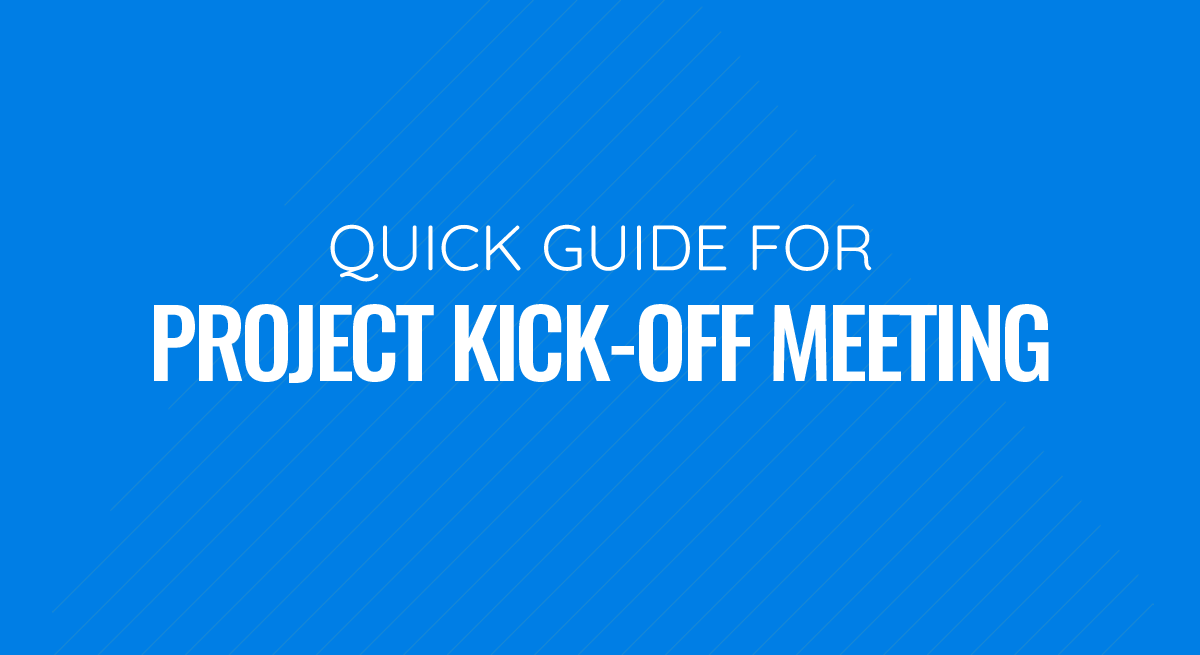
Every project beginning is exciting; all the members will have different expectations and feelings about the required results. Therefore, rapport is crucial to establish commitment and generate a sense of accountability for everyone when beginning a project. The first meetings must be a presentation that can set up the milestones, generate agreements over the scope, and define the tasks.
The Project Kick Off Meeting provides the opportunities mentioned above, so this article will explore the steps to perform a smooth project start and a seamless kick off meeting.
What is a Project Kick Off Meeting?
Let’s begin imagining this simple scenario: people from very different backgrounds (let’s think IT and Marketing) will be starting a project together. Joining these two groups will also be members of the management team, financial experts, and even a project manager who will be in charge of making it all come together. The vision of all these very diverse teams must become aligned for the sake of the project.
Depending on each project needs’, there has to be a clear definition of roles, and everyone will want to know what is expected from them. Having that sense of direction will establish a project flow that will come in handy when there is a need for flexibility.
The project kickoff meeting is the first meeting that will happen between the project team and stakeholders. Regardless of whether they are all internal or external, it’s essential to make sure that the right people are in the conversation, and by right, we mean the ones who will push the project to success. You can find affordable kickoff meeting agenda templates for presentations in our website.
Now that we have cleared that out let’s jump into what makes a project kick off meeting great.
How do you do a Project Kick Off meeting?
The contents of the project kick off meeting can be relatively varied. However, a recommended structure exists to keep everyone on track. This meeting is fundamental not just in the human aspect but mainly as a planning tool where everyone knows who is involved, establishes an initial relationship, and defines a group pledge.
Before the project kick off meeting
Planning the project kick off meeting can be of great help for a smooth start. In your first steps to preparing your kickoff deck presentation, it’s important to consider where you need to allocate your resources.
Define the impact of the project along with and metrics that state how the project will succeed. Remember to use SMART Goals: specific, measurable, actionable, realistic, and timely. This way, you will ensure that your project does not stray away from the vision and that all the project members are on the same page about timeframes, reach, and capacities.
Identify the key players to attend the project kick off meeting
Once you have these logistics in place, have a one-on-one chat with the Project sponsor to align expectations. Also, it’s a good time to ask them to prepare some words about why this project is relevant to the organization.
Ensure you additionally identify the Project Leader, facilitator, core team, and relevant stakeholders during this time. At this point, for your internal tracking and your eventual presentation during the meeting, you can use the RASCI model that will allow you to identify who is Responsible, Accountable, Supportive, Consulted, and Informed roles. You can iterate over this model during the meeting if you need changes or have the different players define their roles.
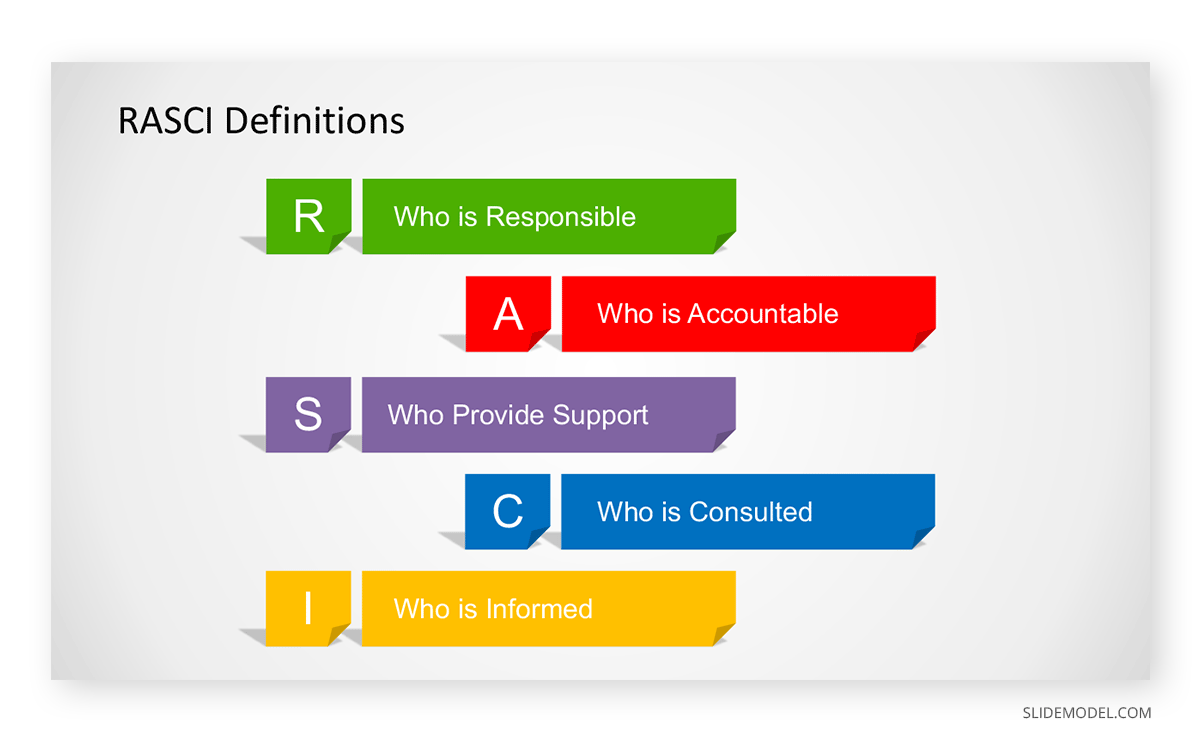
Project Kick Off Meeting Agenda
By this point, you have met and identified top stakeholders, and it’s time to take care of some meeting basics. Begin by setting up 1-2 dates and hourly options that can be more convenient for everyone in the team. If you’re working remotely, take into account time zones, and if you’re local, check if there is a meeting room or space available at the given times. As soon as you can, ideally at least a week before, send out all meeting invites and ad reminders for everyone.
Now it’s time to define the project kick off meeting agenda; remember this is not information debrief only, but a get-together where you will level with all parts to make sure agreements are established.
Now let the project kick off meeting begin!
All the required team members show up on time; we notice some of the marketing team members share comments of excitement about the project and ask some first exploratory questions to the IT team. It’s time to start.
Start by welcoming everyone, and then move forward to the project kick-off principles: collaboration is required to generate more reliable results, find as much data possible to have a shared understanding, open up to possibility, and share a positive mindset.
Good practices in the Project Kick Off Meeting Start
If you want to go the extra mile, this is a great opportunity to showcase the Project Charter, including the goals, team, timeline, and scope to understand visually. During the meeting, you can even send out the Project Charter as a pdf for everyone to keep and even print at will.
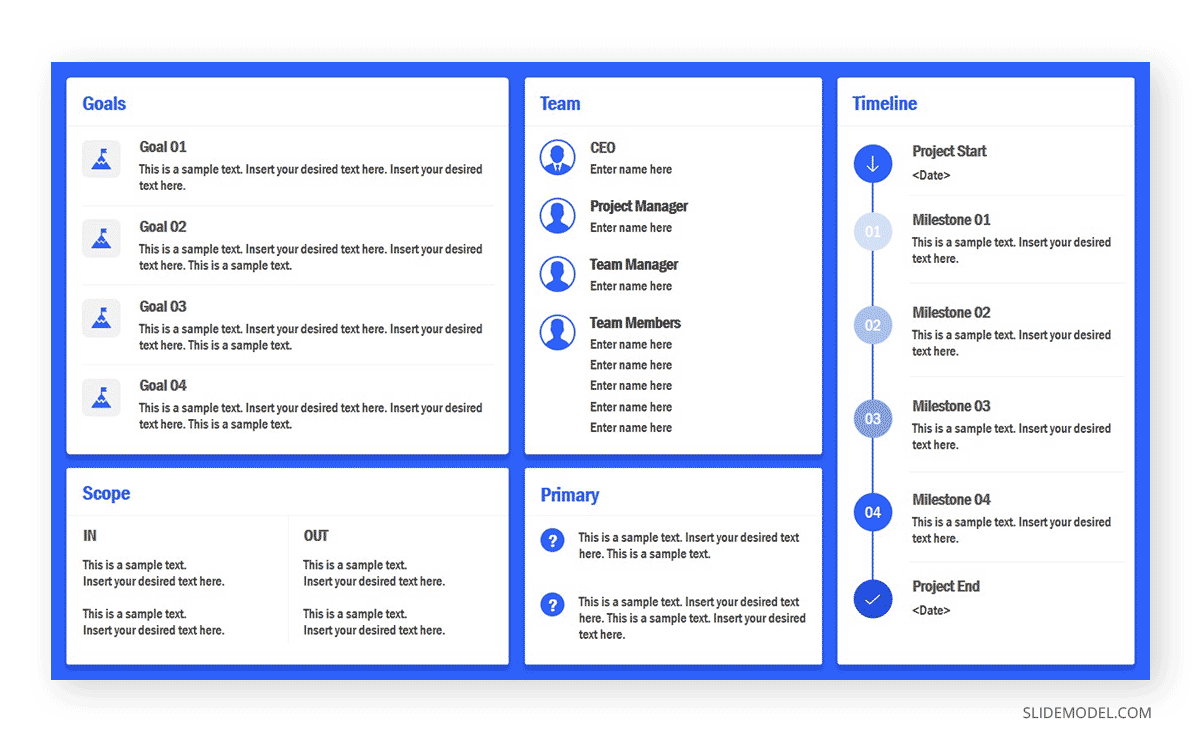
Also, you can structure the first minutes of the kickoff presentation as a simplified elevator pitch to establish the problem and solution upfront.
Remember that in SlideModel.com we have a wide array of templates you can use for your project planning business presentations, you can check out the Project Management Pack PowerPoint Templates which is one of our most comprehensive templates.
Structuring your Project Kick Off Meeting
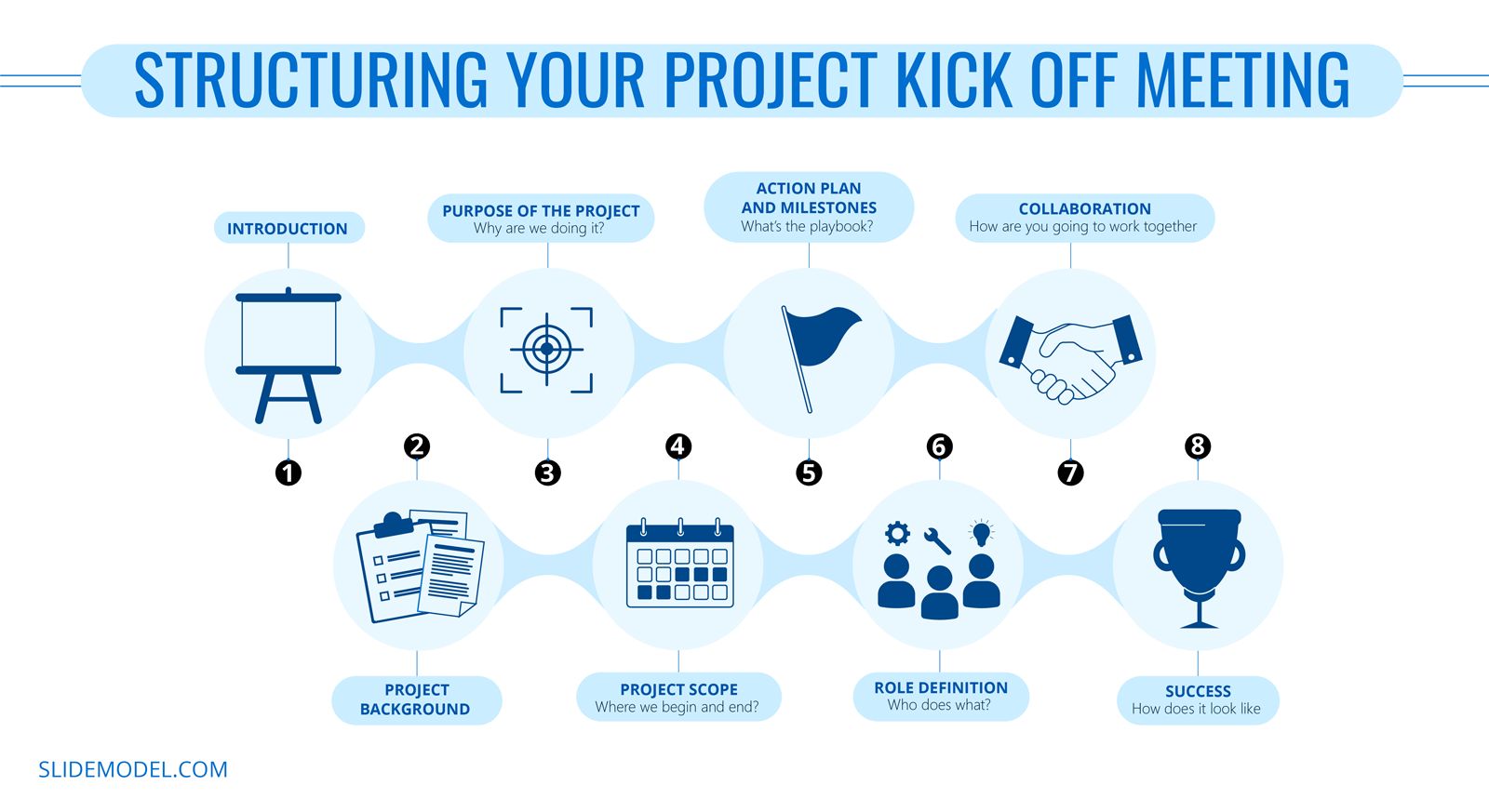
As we’ve seen until this point, the project kick off meeting is important meeting and eventful. Therefore we want to recap what your meeting agenda should include.
1. Introduction
In every concurred meeting with people from different teams, it’s a good idea to consider not everyone knows each other. Begin with a brief round of introductions. As a protip, provide them with a little script that includes name, team, and role to keep it short and candid, i.e., ¨My name is Donald, and I’m the Development Lead¨
2. Project Background
It’s good for all parties to know where the project is coming from and share essential lessons from similar projects like it or similar stakeholders.
3. Reason or purpose of the project: Why are we doing it?
This is a perfect moment to introduce the Project Sponsor as they will want to share the project’s vision and why its execution is vital to the organization. Their intervention can either happen as the first item on the meeting. It can happen after the introduction or even after the project charter, but the sponsor’s short speech is a must.
4. Project Scope: Where we begin and end?
The project’s beginning and end are conceptually closer than we might think. As Stephen Covey said ¨start with the end in mind¨, is a great tip for this moment because while discussing and defining the project scope, everyone can get aligned and know what is expected from the final product ahead.
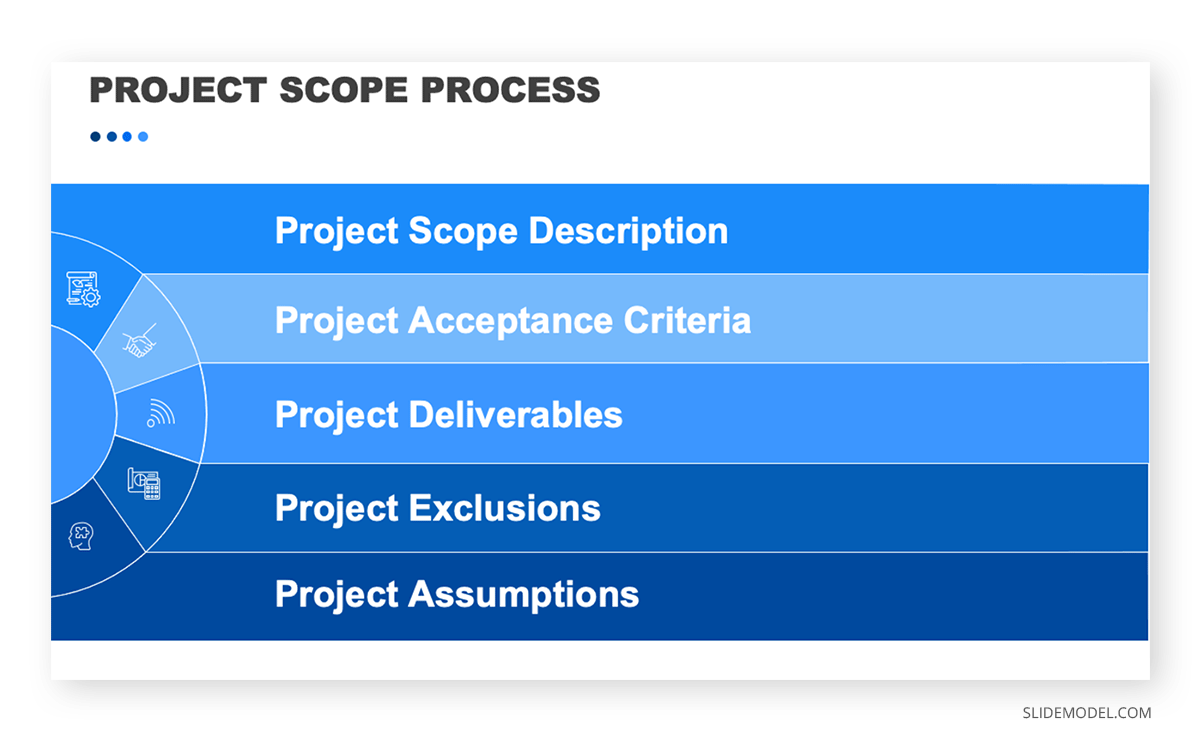
5. Action plan and milestones: What’s the playbook?
The project charter might come in handy here, as it will help build a general comprehension of what the project must look like. It’s essential to have an action plan with actionable steps to allow everyone to know what tasks must be done. Eventually, this can become the project backlog and can serve as a playbook to revise in retrospectives.
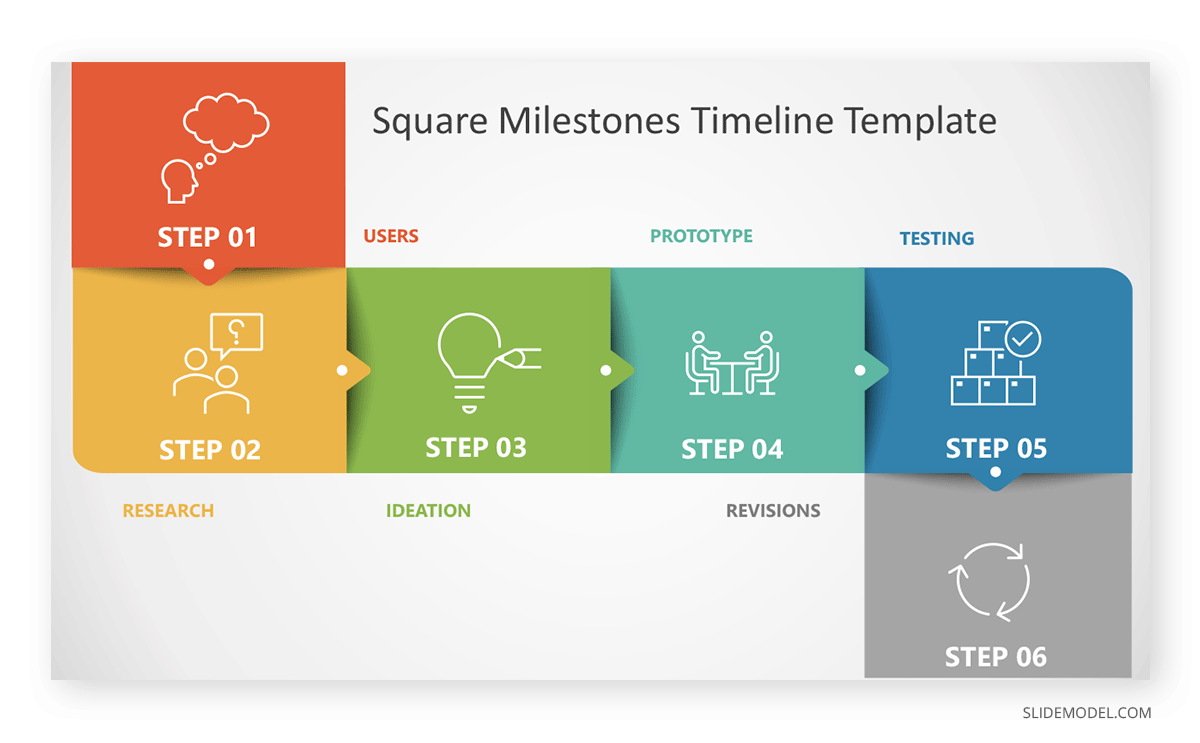
6. Role definition: Who does what?
Even though everyone will come to the meeting with certain expectations, it’s recommended that you and the project sponsor are clear on who will perform which task. This way, accountability can be established since the first encounter, and responsibility can be provided to each in their area.
7. Collaboration: How are you going to work together
Regardless of whether the tool is physical or virtual, it’s a great idea to show the team where all the information will be set. There are several tools out there that are great for project management. However, a tool like Trello, for example, will allow you to create Kanban boards that will allow a clear ¨to do¨, ¨in process¨and ¨done¨ methodology that includes high visibility. Afterward, you can convert those Trello Boards into presentations that can be used in daily meetings or other relevant project meetings.

8. Success: How does it look like
Along the way, many opportunities will show up. However, it’s great to know the true north of the project. Ensuring everyone knows what success looks like in this project will ensure that all the people in the project have the same goal and won’t be stuck in analysis paralysis. Ensure that there is absolute clarity about this last step and what are the final results expected.
Key concepts about the project and establishing rapport
In your role as a presenter, you have delivered vital information about the project, introduced the project sponsor, and everyone now knows the project’s vision. It’s time to get people interacting to know each other, break the ice and get ready to work in synchronicity.
At this point of the meeting, you want all attendees to take ownership of the project and establish their working agreements. To do this, a simple but yet effective ice breaker can be a great way to go. Share the Vision, Mission and Mission tests that the Project Leader has created and start with the activity.
Separate your attendees into 3 groups: Vision, Team Mission, and Team Mission tests. They don’t have to be together with people of their specific area (i.e., Marketing, IT, etc.); this can be random to mix people so they can meet each other. Give each mini-team 20 minutes to refine the initial statements and define any specific they have to improve the project.
How to finish the Project Kick Off Meeting Closing and Next Steps
The first steps have been completed. To close the meeting, provide some minutes to your Project Sponsor for the last hype to your team. The upcoming weeks or months will be full of tasks to complete, and in the end, that same team you gathered today will have completed a successful new solution.
After the meeting is over, make sure you set up the next steps, including the kick-off meeting, setting up planners and software, and preparing materials for all the involved. Remember to set up Key Performance Indicators (KPI’s) so that all the objectives will be measured timely for the best results.
Final Words
Congratulations, you have conducted your first Project Kick Off Meeting! However, it’s not time to lay back and relax but actually to keep the momentum going. Your team had the information to begin, but now there needs to be a solid follow-up to ensure the tasks will be done as per the previous agreement.
Hopefully, the first meeting will have set up the event tone, and all the parts are equally invested in the new project to come.



